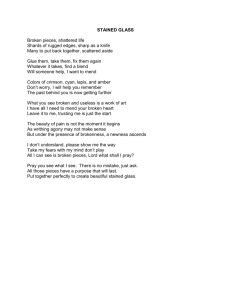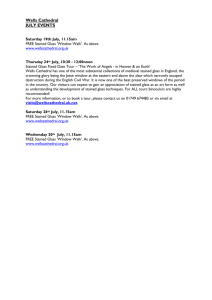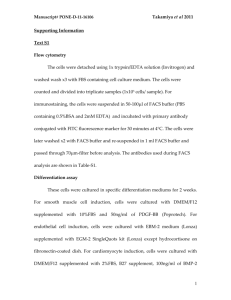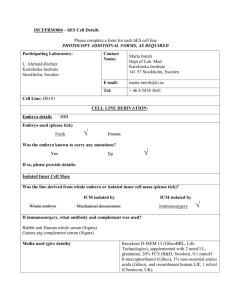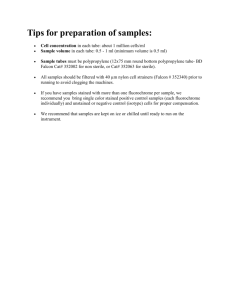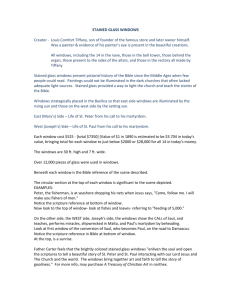Supplementary Methods (doc 36K)
advertisement
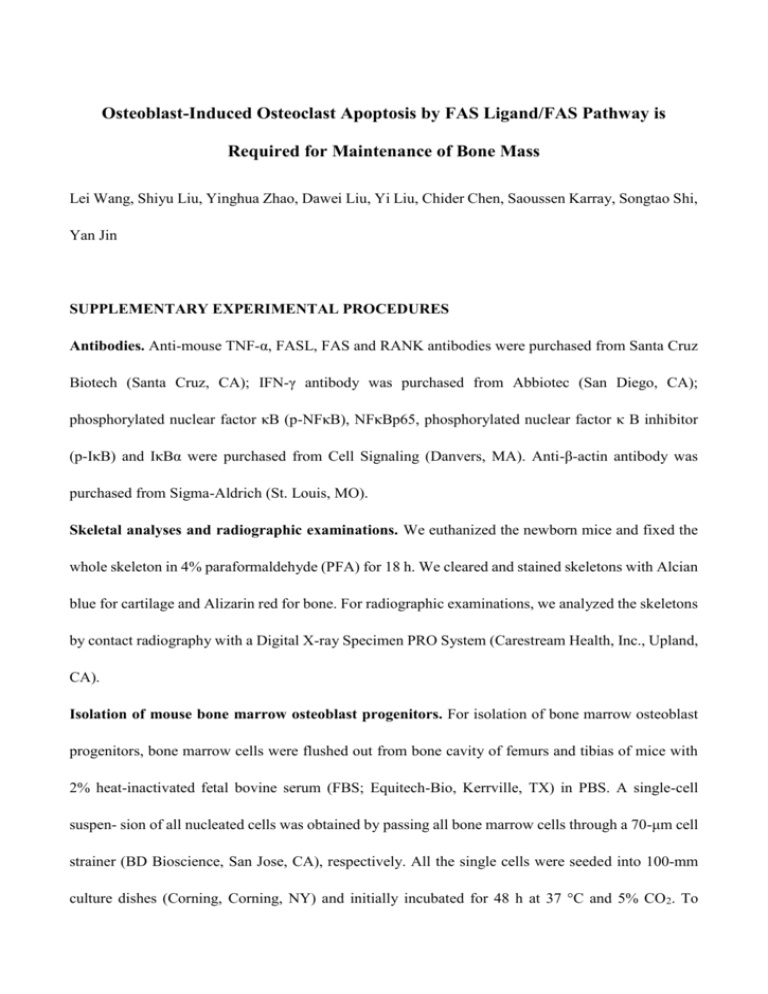
Osteoblast-Induced Osteoclast Apoptosis by FAS Ligand/FAS Pathway is Required for Maintenance of Bone Mass Lei Wang, Shiyu Liu, Yinghua Zhao, Dawei Liu, Yi Liu, Chider Chen, Saoussen Karray, Songtao Shi, Yan Jin SUPPLEMENTARY EXPERIMENTAL PROCEDURES Antibodies. Anti-mouse TNF-α, FASL, FAS and RANK antibodies were purchased from Santa Cruz Biotech (Santa Cruz, CA); IFN-γ antibody was purchased from Abbiotec (San Diego, CA); phosphorylated nuclear factor κB (p-NFκB), NFκBp65, phosphorylated nuclear factor κ B inhibitor (p-IκB) and IκBα were purchased from Cell Signaling (Danvers, MA). Anti-β-actin antibody was purchased from Sigma-Aldrich (St. Louis, MO). Skeletal analyses and radiographic examinations. We euthanized the newborn mice and fixed the whole skeleton in 4% paraformaldehyde (PFA) for 18 h. We cleared and stained skeletons with Alcian blue for cartilage and Alizarin red for bone. For radiographic examinations, we analyzed the skeletons by contact radiography with a Digital X-ray Specimen PRO System (Carestream Health, Inc., Upland, CA). Isolation of mouse bone marrow osteoblast progenitors. For isolation of bone marrow osteoblast progenitors, bone marrow cells were flushed out from bone cavity of femurs and tibias of mice with 2% heat-inactivated fetal bovine serum (FBS; Equitech-Bio, Kerrville, TX) in PBS. A single-cell suspen- sion of all nucleated cells was obtained by passing all bone marrow cells through a 70-μm cell strainer (BD Bioscience, San Jose, CA), respectively. All the single cells were seeded into 100-mm culture dishes (Corning, Corning, NY) and initially incubated for 48 h at 37 °C and 5% CO 2. To eliminate the nonadherent cells, the cultures were washed with PBS twice on the second day. The attached cells were cultured for 16 d with alpha minimum essential medium (α-MEM, Invitrogen, Grand Island, NY) supplemented with 20% FBS, 2 mM L-glutamine (Invitrogen), 55 μM 2-mercaptoethanol (Invitrogen), 100 U/ml penicillin and 100 μg/ml streptomycin (Invitrogen). To confirm mesenchymal stem cell character, flow cytometric analysis was used to show that these osteoblast progenitors were positive for CD73, CD90, SCA-1 and SSEA-4 and negative for CD11b, CD31, CD34 and CD45. Population-doubling and proliferation assays. Population doublings (PD) for each passage was determined by using the formula PD≈log2[Nc/No], where No is the original cell population and Nc is the number of cells at confluence, and by adding the PD from each passage together to obtain the PD values. The PD assay for mouse osteoblast progenitors began with passage 1 (P1). For proliferation assay, P1 cells (1 × 104 per well) were seeded on 2-well chamber slides (Nunc) for 1–2 days, incubated with BrdU reagent (1:100, Invitrogen) for 24 hrs, and stained with the BrdU staining kit (Invitrogen), following the manufacturer’s instructions. The cells were lightly stained with hematoxylin solution (Invitrogen). To quantify cell proliferation capacity, we used 10 representative images to calculate BrdU-positive nuclei numbers. Cell proliferation was shown as a percentage of BrdU-positive nuclei over total nucleated cells. Adipogenic differentiation assay. For the adipogenic induction assay, osteoblast progenitors were cultured to confluence and then induced under an adipogenic medium containing 500 μM isobutyl-methylxanthine, 60 μM indomethacin, 0.5 μM hydrocortisone, and 10 μM insulin for 1 week. Cultures were stained with 0.3% Oil red-O after adipogenic induction. The Oil-red O-positive droplets-containing cells were counted and shown as a percentage of Oil-red O-positive cells over total cells. Western blot analysis. Total protein was extracted using M-PER mammalian protein extraction reagent (Thermo). Nuclear protein was obtained using NE-PER nuclear and cytoplasmic extraction reagent (Thermo). Protein was applied and separated on 4-12% NuPAGE gel (Invitrogen) and transferred to ImmobilonTM-P membranes (EMD Millipore, Billerica, MA). After blocking with 5% non-fat dry milk for 1 hour, the membranes were incubated with the primary antibodies (1:200-1000 dilution) at 4 ºC overnight. Horseradish peroxidase-conjugated IgG (Santa Cruz) was used to treat the membranes for 1 hour and subsequently treated with a chemiluminescent substrate (Thermo). The bands were detected on BIOMAX MR films (Kodak). Each membrane was also stripped using a stripping buffer (Thermo) and reprobed with anti-β-actin to determine the loading amount. Flow Cytometry Analysis for HSCs and T cell subsets. Cells were stained by standard protocols with the following antibodies (eBiosciences unless otherwise noted). To determine the population of HSC-enriched Lineage–Sca-1+c-Kit+ (LSK) cells, long-term HSCs (LT-HSCs, Lineage– Sca-1+c-Kit+Flk2–CD34–) and short-term HSCs (ST-HSCs, Lineage–Sca-1+c-Kit+Flk2–CD34+), bone marrow cells freshly harvested from femurs and tibias were stained with a cocktail of PE-conjugated B220, TER119, CD3e and CD41; PerCP-conjugated Sca-1; APC eFluor780-conjugated c-Kit; FITC-conjugated CD34 and APC-conjugated Flk2. Multiparameter FACS analysis was performed on a LSRII (BD Bioscience, San Jose, CA). For analysis of Th1 and Th2 cells, 1–2×106 splenocytes were activated with 5 ng ml-1 phorbol 12-myristate 13-acetate (PMA, Sigma Chemical Co., St. Louis, MO), 250 ng ml-1 ionomycin (Sigma) and 1 μg ml-1 brefeldin A (GolgiPlug, BD Bioscience, San Jose, CA) for 4 hours at 37°C and 5% CO2, followed by incubation with 1 μg of PerCP-conjugated anti-CD4 antibody for 30 min on ice under dark condition. After cell fixation and permeabilization, cells were stained with 1 μg of APC-conjugated anti-IFN-γ or IL-4. Isotypematched APC- or PerCP- conjugated IgGs were used as controls. For Foxp3 intercellular staining, T cells were stained with anti-CD4 and -CD25 antibodies (1 mg each) for 30 min on ice. Next, cells were stained with anti-Foxp3 antibody using Foxp3 staining buffer kit (eBioscience). For IL17 staining, T cells were stained with anti-CD4 antibody and then stained with anti-IL17 antibody using Foxp3 staining buffer kit. After washing with PBS/0.4%BSA 3 times, all samples were analyzed with FACScalibur (BD Bioscience, San Jose, CA). Apoptosis PCR array. To profile the expression of key genes involved in programmed cell death, a mouse Apoptosis RT² Profiler PCR Array (SABiosciences, Frederick, MD) was used according to the protocol of the manufacturer. Briefly, total RNA was isolated from the cultures using SV total RNA isolation kit (Promega, Madison, WI) according to manufacturer’s instructions. The cDNA was synthesized from 100 ng of total RNA using RT² First Strand Kit (SABiosciences). cDNA was added to SYBR Green qPCR Master Mixes (SABiosciences), and the mixture was aliquoted across the PCR Array, followed by running in the BioRad CFX96TM Detection System (BioRad). Data analysis was performed on the manufacturer’s Web portal at http://www.SABiosciences.com/pcrarraydataanalysis.php by converting raw Ct data to fold–change results.

